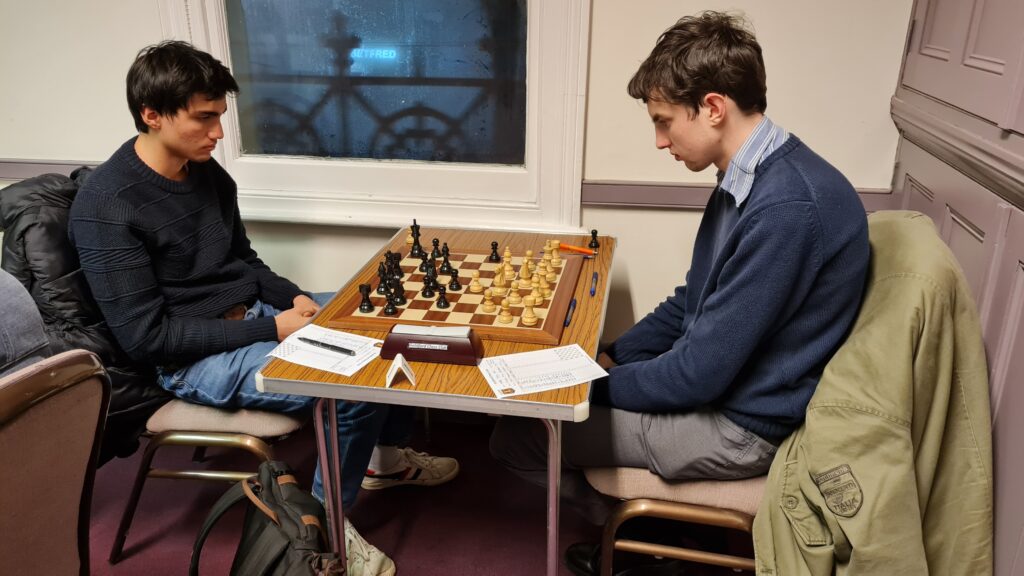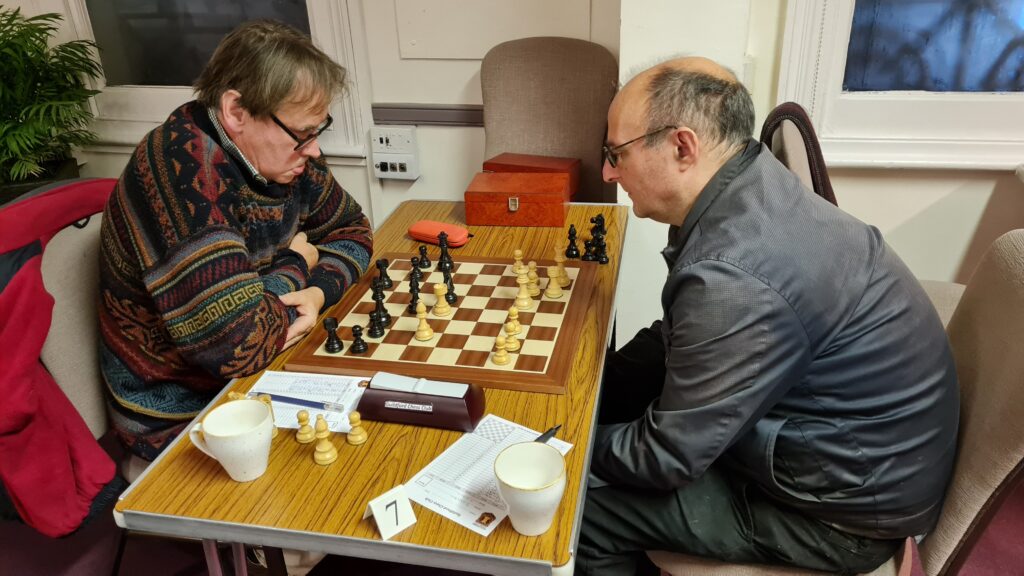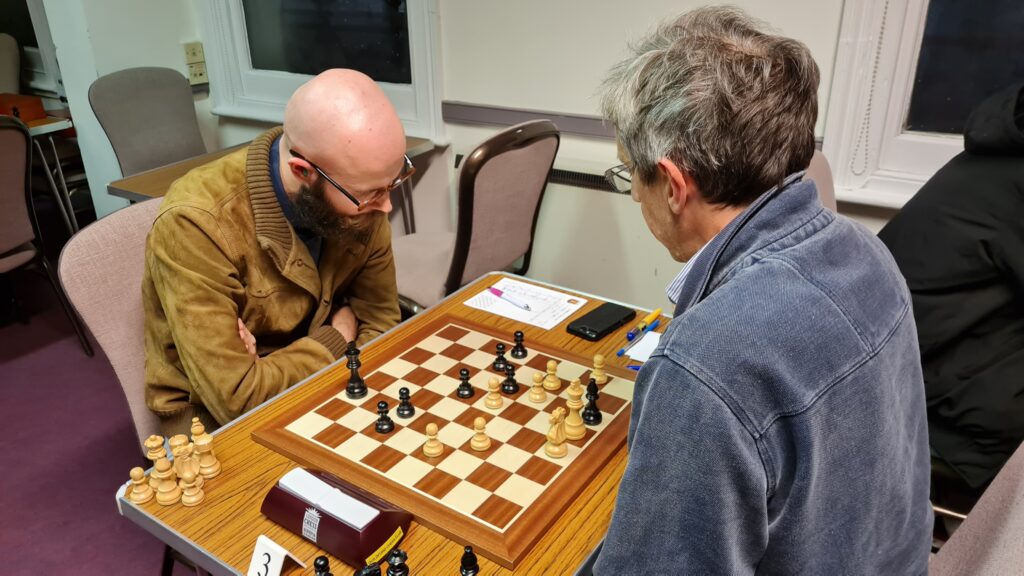Surrey League division 1 match played at the Guildford Institute on 6 November 2023

All good things come to an end. The first team had not lost since the pandemic, but the run perished on a cold Monday away at Guildford. Depleted by the absence of several regulars, we still had the rating edge on the top three boards but were outrated on the lower five.
Your reporter was one of the absentees, but returned from a bridge tournament in Athens halfway through the session. By that time, Alan Scrimgour had drawn a short game on board 6; an innovative placement of his bishops against the Caro-Kann had not come off, and the tension soon evaporated.
On board 8, Stephen Moss, who had kindly deserted the fourth team to fill a gap, had misplayed the opening against a youngster who was moving very quickly. Stephen was already starting to feel time pressure when he found an opportunity in this position.
He played Nxa7+ Rxa7 Bxb6+, and had hoped this would win the rook outright, leaving him the exchange ahead, having missed Rc7. The combination still won a rook and two pawns for two minor pieces, and the three connected passed pawns on the queenside looked good. But after White lost an important tempo, the black king was well placed to hold them up without the support of the white rook, while on the other side the black pawn majority supported by the two bishops soon overwhelmed White.
John Foley on board 5 had a fairly short draw. He had had the better of the black side of a Caro-Kann up to the position below. It looked natural to equalise material and attack the white queen with 12… Nxe5. But it was better to be patient: 12… d4 13. Ne4 (or Na4 Qa5 14. b3 Nf5 and either the g- or e-pawn will fall) Qxb2 14. Nd6+ Kf8 15. Rc1 Rd8 16. Qb5 Qxb5 17. Nxb5 Nxe5 and Black has a significant advantage. Thereafter the game soon petered out as a draw; still a decent result as Black.
Jon Eckert on board 7 came under some pressure in the opening as his king was forced to d7. But he found some counter-chances, and his opponent’s sacrifice of a piece for two pawns, although dangerous, looked unsound. However, Jon ignored a routine recapture in favour of a move which he wrongly thought was winning, and found himself two pawns down in an ending. Bishops of opposite colours gave him a chance, but his opponent lost or sacrificed his bishop for another pawn, and Jon’s bishop could not hold all the pawns.

David Rowson’s Alapin Sicilian resulted in an IQP (isolated queen’s pawn) position with which he never felt comfortable, as he struggled to get middle game play sufficient to compensate for the long-term weakness. He felt under pressure before the point at which Stockfish first felt his position was materially worse. In the position below, David played the natural Be3, when Qe3 was recommended. After 22… Bb8 23. Rc5 Qd6 threatening mate in two, 24. f4 was forced, but that left the white king far too exposed and Black soon won decisive material.
David Rowson’s game was nevertheless still alive for long enough that we had chances to hold the match if our top three scored heavily. Peter Lalić, who has recently threatened some “slowdown” chess, holding level middle games and grinding his opponents in endings, stayed true to his earlier “rushdown” principles against Surrey county captain Clive Frostick, gambiting an early pawn for free play. Eventually that free play led to regaining the pawn, but that left too little tension in the position and a draw was agreed.

When I first toured the room, I found it difficult to understand the games on the top two boards. And having played them through with help from electronic intelligence, I still find them difficult!
David Maycock played an early g5 in front of his castled king which most of us would not have considered, and which encouraged his opponent to play h4.
I was surprised when David accepted the pawn sacrifice, apparently opening up his king, but it seems to be the best move.; White is too undeveloped to exploit the open files, the h4 pawn is well protected, and for the moment controls g3. The advantage fluctuated until White finally regained the lost pawn with 25. Rxh4, which misplaced his rook.
David found 25…Be4, which contains the sort of trap which often wins games. Any sensible rook move roughly holds the balance. Instead the natural 26. Bxe4 allowed Rxe4 pinning the knight on g4 to the rook on h4. After 27. f3 f5 (the point of Be4 was to clear the way for this pawn, in turn opening an attack by the queen against the rook on h4 while the pawn hits the knight on g4) 28. Rh1, David could have won two pieces for a rook with Rxe2 followed by fxg4, but instead played a crushing exchange sacrifice; after 28… fxg4 29. fxe4 Nxe4 he was dominating the board, and with Qg5 and Rf8 set up an irresistible attack.
In the position below, Black is threatening Bf4+ and g3, trapping the K. White could only find Ng3, giving up the knight and losing in short order.
Mike Healey’s game with White against Roger Emerson on board 2 was even harder to follow, not helped by extreme time pressure. Computer analysis shows that it was only in time pressure that he wriggled out from being slightly worse, and at one point lost, to winning. The last 20 moves, which is when much of the action happened, have had to be reconstructed.
This was the position after White’s 30. Kh2, close to the point when he stopped recording (ie had less than five minutes on his clock):
It seemed to me that White now had the edge, with more room for manoeuvre, and Black’s queen’s bishop even sillier than White’s. But Black has a strong plan here: Bb7 followed by Bc8 lines up a dangerous attack against White’s king.
In the position below, White is lost. Black can play 34… Nxe4, and Qxe4 is not possible because of Qxh3 mate. The white pawn on d5 is weak, and Black can play Nd2 to swap off the white king’s bishop, which would otherwise be activated by the loss of the d4 pawn.
After Black had missed that chance, this position was reached, with White to play his 43rd move:
Now White is on top, and after 43. Nxb5 g5 (hoping to exploit the pin on White’s f-pawn) 44. e5 set problems (an attack on the queen and on the knight on h7) which Black failed to solve. (Remarkably, Stockfish says this position is equal, whereas White could have won with the highly unnatural Na7). Why, when White is winning a piece? Because the black counter-attack is dangerous. The last critical position arose after 49. Kf1:
Now 49… Rh2 followed by 50. d7 Bxd7. 51. Qxd7 f2 would have forced White to play for perpetual check by 52. Qc8+ Kg7 53. Rxg5+ Qxg5 54. Qg8+. Instead Black played 49… Rg3, and after 50. d7 Bxd7 51. Qxd7 Kg7 52. Qd4 Qxd4 53. Nxd4 Black resigned; the three extra pawns do not compensate for two extra pieces.
This was the last game to finish, and by the end it was clear that it was only a consolation goal for Kingston, but to have games of this originality and excitement on the top boards is indeed consolation for lovers of our game who can look beyond mere results. For the rest of us, we hope to do better when Epsom come to Fortress Willoughby at the end of the month.
Peter Andrews, Kingston 1 captain in Surrey League division 1

